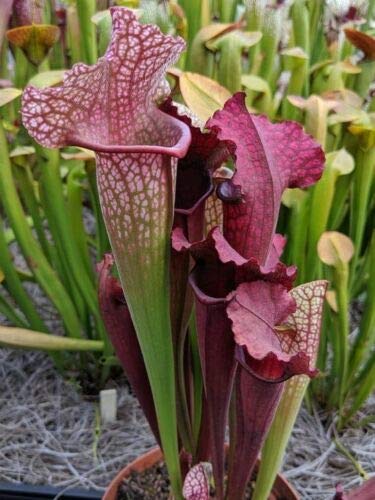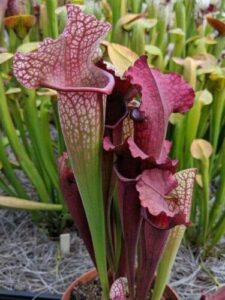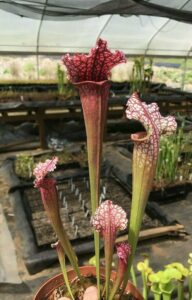Willy Green
July 10, 2023



The Enchanting World of Mini Pitcher Plants: Nature’s Carnivorous Marvels

Step into the captivating realm of mini pitcher plants, where the beauty of nature and the intrigue of carnivorous plants intertwine. These diminutive wonders, derived from the larger Nepenthes species, bring the fascinating world of pitcher plants into a compact and manageable form. With their striking colors, intricate structures, and unique feeding habits, mini pitcher plants have earned a special place in the hearts of plant enthusiasts. In this article, we will delve into the captivating features, cultivation tips, and the allure of these mesmerizing botanical gems, known as the mini pitcher plant.
Unveiling Nature’s Miniature Marvels

Mini pitcher plants offer an enchanting spectacle, showcasing the diversity of form and color within the Nepenthes genus. Ranging from just a few centimeters to around 15 centimeters (6 inches) in length, these compact versions of their larger counterparts boast exquisite pitcher-shaped leaves. Each pitcher is a marvel of engineering, featuring intricate patterns, textures, and hues that beckon curious observers. From the delicate veining to the vibrant hues of red, green, yellow, or even variegated blends, mini pitcher plants bring a touch of exotic beauty to any space they inhabit.
The Carnivorous Lifestyle
What truly sets mini pitcher plants apart is their unique feeding mechanism. Like their larger relatives, they employ a captivating strategy to trap and digest insects and small prey. The pitcher-shaped leaves, often adorned with lid-like structures, lure unsuspecting insects with nectar and enticing colors. Once inside, downward-pointing hairs and slippery surfaces prevent escape, ultimately leading the prey into the digestive fluid at the base of the pitcher. This fluid contains enzymes that break down the captured insects, providing vital nutrients for the plant’s survival in nutrient-poor habitats.
Beyond their visual appeal and captivating feeding habits, mini pitcher plants offer additional benefits and opportunities for plant enthusiasts. Here are some further aspects to explore and appreciate:
-
Educational Value: Mini pitcher plants provide an excellent opportunity for education and exploration. Their unique carnivorous adaptation sparks curiosity and allows for fascinating discussions about the diversity of plant life and the strategies they employ for survival. Children and adults alike can learn about the delicate balance of ecosystems and the intricate relationships between plants and insects.
-
Conservation Awareness: Many species of pitcher plants, including their mini counterparts, face threats due to habitat loss and illegal poaching. By cultivating and appreciating mini pitcher plants, plant enthusiasts can contribute to conservation efforts. Supporting reputable nurseries and advocating for the protection of these remarkable plants can help preserve their natural habitats and ensure their survival for future generations.
-
Terrarium and Indoor Gardening: Mini pitcher plants are a popular choice for terrariums and indoor gardening due to their compact size. These enclosed environments provide the perfect conditions for these plants to thrive, creating a self-contained ecosystem that can be enjoyed up close. Terrariums also offer the opportunity to create visually stunning displays, incorporating other plants and decorative elements to enhance the overall aesthetic.
-
Crossbreeding and Hybridization: The world of mini pitcher plants offers a breeding ground for hybridization and the creation of new cultivars. Plant breeders and enthusiasts have been successful in crossbreeding different Nepenthes species to produce miniature varieties with unique characteristics. This ongoing process adds to the diversity and excitement surrounding mini pitcher plants, with each new cultivar boasting its own distinct traits and appearance.
-
Therapeutic Benefits: Engaging with plants, including mini pitcher plants, has been shown to have therapeutic benefits. Caring for these captivating plants can provide a sense of relaxation, reduce stress, and improve overall well-being. The process of nurturing and observing the growth of these unique plants can be a rewarding and fulfilling experience.
Cultivating Mini Pitcher Plants
Bringing the allure of mini pitcher plants into your home or garden requires an understanding of their specific care requirements. Here are some essential guidelines to help you cultivate these captivating carnivorous plants:
-
Light and Temperature: Mini pitcher plants thrive in bright, indirect light. Place them near a window with filtered sunlight or provide them with artificial light if necessary. They prefer temperatures between 70-85°F (21-29°C) during the day and a slight drop in temperature at night.
-
Humidity and Moisture: These plants thrive in high humidity levels. Mist the foliage regularly or place the plant on a tray filled with water and pebbles to maintain a humid environment. Ensure that the soil remains evenly moist, but avoid waterlogging.
-
Soil and Water: Use a well-draining soil mix specifically formulated for carnivorous plants, such as a blend of sphagnum moss, perlite, and sand. Water with distilled or rainwater, as tap water may contain minerals that can harm the plants.
-
Feeding: While mini pitcher plants derive their nutrients from captured insects, occasional feeding with small insects like fruit flies or ants can supplement their diet. However, this is not a strict requirement for their survival.
-
Dormancy: Some mini pitcher plants, particularly those from temperate regions, undergo a period of dormancy during cooler months. Reduce watering and provide cooler temperatures during this time to simulate their natural growth cycle.
Propagation
Propagating mini pitcher plants can be a rewarding process that allows you to expand your collection or share these fascinating plants with others. Here are a few common methods for propagating mini pitcher plants:
-
Leaf Cuttings:
-
Select a healthy and mature leaf from the parent plant. Choose a leaf that has an intact portion of the stem attached.
-
Using a sterile and very sharp knife or scissors, carefully cut the leaf from the parent plant, ensuring that the stem is still intact.
-
Fill a small container with a well-draining medium, such as a mix of sphagnum moss and perlite.
-
Plant the cut end of the leaf into the medium, burying it deep enough to provide stability.
-
Place the container in a warm and humid environment, ideally with bottom heat, as this promotes root development.
-
Mist the leaf cutting regularly to maintain high humidity levels and prevent it from drying out.
-
Over time, the leaf cutting will develop roots, and eventually, new growth will emerge from the stem.
-
Tissue Culture:
-
Tissue culture is a more advanced method of propagation that requires sterile laboratory conditions. It involves taking a small piece of tissue from the parent plant and growing it in a nutrient-rich agar medium.
-
This method is commonly used by nurseries and specialized growers to mass-produce mini pitcher plants.
-
Tissue culture allows for the rapid multiplication of plants and the production of genetically identical specimens.
-
Division:
-
Some mini pitcher plants can be divided by separating their rhizomes, which are underground stems.
-
Carefully remove the plant from its pot and gently separate the clump of rhizomes into smaller sections, making sure that each section has a portion of the root system.
-
Plant the divided sections in individual pots filled with a suitable carnivorous plant soil mix.
-
Provide the divided plants with the same care and conditions as mature plants.
It’s important to note that not all mini pitcher plant species or cultivars can be easily propagated through these methods. Some may have specific requirements or may be challenging to propagate using traditional methods. It’s always best to research the specific species or cultivar you are working with and consult resources such as plant care guides, online forums, or experienced growers for more detailed instructions and guidance.
Conclusion: In the enchanting world of mini pitcher plants, beauty, and carnivorous allure collide, captivating plant enthusiasts with their compact size, striking colors, and captivating feeding mechanisms. Whether adorning a windowsill or adding an exotic touch to a terrarium, these botanical marvels invite us to witness the wonders of nature on a smaller scale. With proper care and appreciation for their unique needs, mini pitcher plants reward us with their captivating presence and serve as a constant reminder of the extraordinary diversity found within the plant kingdom. Thank you for reading The Enchanting World of Mini Pitcher Plants: Nature’s Carnivorous Marvels. Here are some other articles you may enjoy reading.






